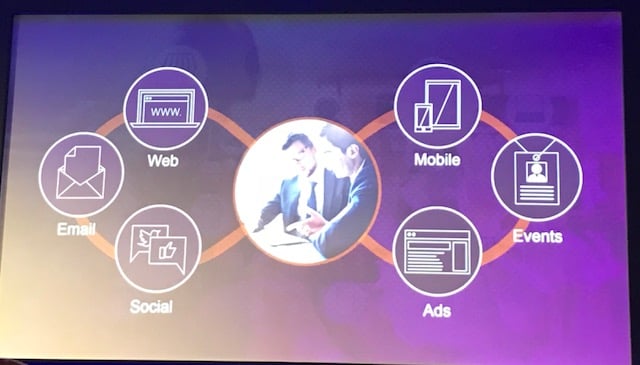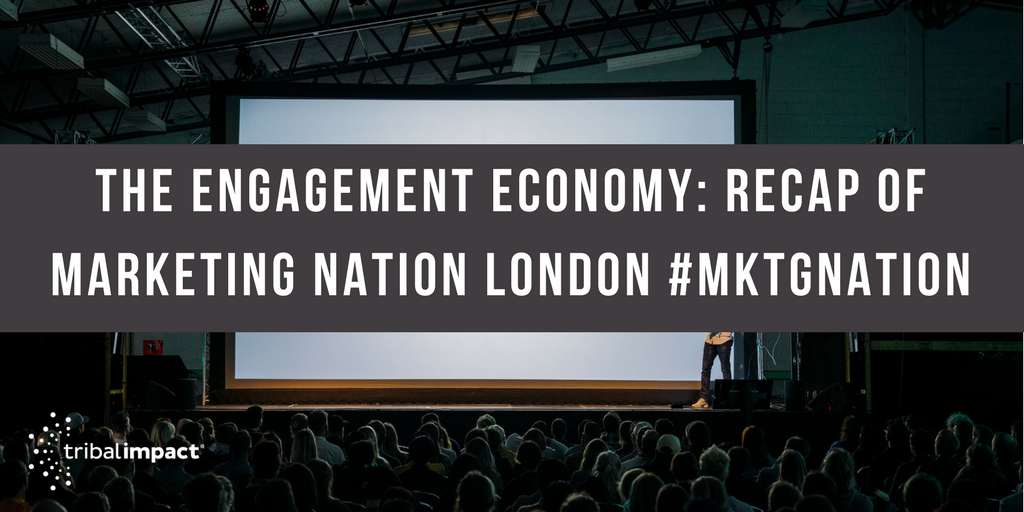
In short, it was superbly organised (I guess you’d expect best-in-class from a marketing company), the speakers were relevant and the content right on trend.
Given my eyes aren’t what they used to be (I assume it’s because I’m an ageing Mum) I sat near the front which was wonderful for several reasons. First, I could see what was going on and take good photos. Second, I got to sit near the keynote speaker (and my good SAP friend) Michael Brenner. Third, all my customers and friends seem to be hanging around in the same spot #lucky.
Anyway, I recorded a video on LinkedIn after the event but I also wanted to summarise my key takeaways. Did I miss any?
Marketing Is No Longer A Function. It’s A Game Changer.
Anyone who has studied Strategic Marketing will know our profession is so much more than “logos and lunches”. It’s about aligning to business strategy, understanding market opportunities and aligning with sales to generate revenue. So, when I found out that Jamie Anderson (ex-SAP Hybris CMO) had just joined Marketo as President for EMEA I realised that times are really changing.
Marketing professionals are now stepping into business leadership roles. Roles that are traditionally filled by finance or sales professionals. Companies like Marketo are recognising that when you place marketing (and all the data, analytics etc) at the heart of your business, you will understand your customer like never before.
I’m paraphrasing the key points Jamie made here, but you’ll get the idea…
- Sales run on quarters – 90 day tactical planning
- Product development run to 18-24 month cycles – sometimes longer
- Marketing sits right in the middle. Planning ahead with development whilst partnering with sales to move pipeline along.
- If you place marketing at this point in your business, you’ll win
- It’s what Marketo calls the Engagement Economy
- Economies come and go – where there’s an abundance of something and a scarcity of something else
- Industrial economy: Abundance of people + scarcity of product = Mass products produced
- Consumer economy: Abundance of products + scarcity of demand = Mass advertising era
- Digital economy: Abundance of consumers + abundance of demand = Abundance of noise!
- Marketers need to cut through the noise.
Forget The Funnel. Marketing Is About An Infinite Loop Of Interactions
Greg Woolfe, COO of Marketo, talked humorously about the traditional funnel and the different interpretations of a funnel. Putting a funnel on its side doesn’t quite cut it. According to Marketo, it’s now an infinite loop of interactions. The cycle never ends. As a customer, you never drop out of the funnel. You’ll always be engaged in the funnel but just in a slightly different role e.g. an advocate or ambassador for the brand.
Content in this loop needs to be relevant and authentic. That was the key message.
If You’re Not Listening, You’re Not Learning.
Jason Sibley, CEO of Creation Agency, then took the stage to talk about “The Partnership Between Sales & Marketing” and asked the question “How many of you here have spoken to a customer in the last 2 weeks?” About 10% of the audience raised their hand and you know what? I’ve spent over 20 years in corporate marketing and I totally get it. In all my years working in what was largely perceived as a support function for sales, I rarely got out to meet customers. Tagging along to a sales meeting feels awkward and staged. Been there. Got the t-shirt.
These days, I speak to my customers every day and I love it. It’s top of my agenda. Here’s an example of what happens when you don’t listen!
My tip: Connect with your marketing peer at your customer. Find the marketing person and connect. Strike up a conversation. You’re talking to the customer – just a different contact within the customer!
Here’s a summary of what Jason covered:
- If you’re not listening, you’re not learning
- Don’t miss an opportunity to learn from sales, from social, from your customers
- How do we (as marketing) engineer an experience that’s bespoke for the customer
- Personalisation is more than adding their name to the top of an email
- It’s about personalising the entire customer experience – understand that person, their motivation, their hobbies, their passion, their interests
- There are six pillars of influence: Authority, Social Proof, Reciprocity, Scarcity, Liking Consistency (see image)
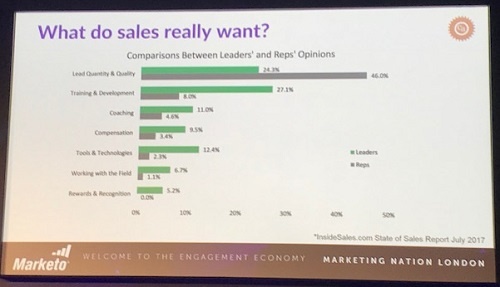
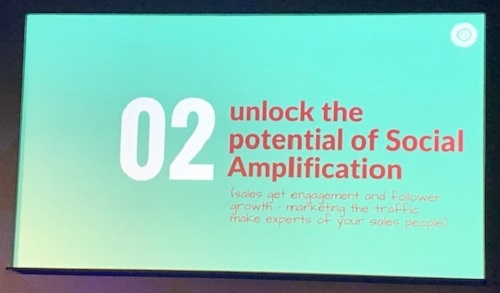
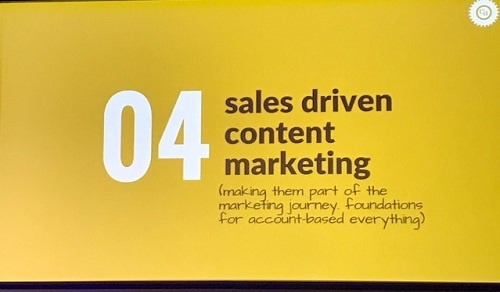
Trust & Transparency Are Critical To The Future Of Marketing
Richard Dunn from Wunderman EMEA presented their latest research into customer loyalty. I really enjoyed this session. It hit me on all levels – as a marketer, as a business owner and as a consumer.
Wunderman call this “Wantedness”. You can learn more about it here. Here’s a summary:
- We live in a world of increasing transparency and decreasing trust
- 9/10 people seek out reviews online before they purchase the product they’re seeking to buy
- Rather than defaulting to big brands, they’re seeking out niche brands that are right for them
- Millennials spend 2X as long researching brands before purchasing. Mobile is driving this behaviour
- Best in class is a standard that runs across all categories, not just the category/industry you’re in
- Customer experiences, product quality – consumers compare their experience of service across all industries
- Companies need to look beyond their industry for best-in-class
- 61% of us value brands that make our life easier. We want companies to remove the friction in our lives with products.
- 89% say a brand must share its values and be true to its values.
- Important that buyers see companies aligning to their values. #OptOutside campaign top class
- 79% of us want brands to care. We want to be understood. We don’t want to have to tell a brand twice about us.
Squeeze The Life Out Of Your Content, Before Creating The Next Piece
Then we had a whirlwind rock-themed presentation from Jason Miller at LinkedIn. This guy is a fast talker with great messages. The irony of the whole thing was that his message was about slowing down and how we as marketers need to do less but make a better job of it. Made me giggle.
LinkedIn have a done a lot of research on content, what performs, what doesn’t, how to AB test to get the best results – Jason shared his insights.
Anyway, it was so fast I couldn’t write notes and just took pictures but here are the key points:
- 50% of all articles published get 8 shares or less (source: BuzzSumo)
- 3 x long form posts a week is optimum – referencable, quality, relevant content for your audiences. Do your research in advance.
- 3 types of post: Power Posts such as How to posts, What posts, List posts (good for shares), Strong opinion posts (good for engagement) and Research posts (good for backlinks)
- Take your top performing content and wrap it up into a magazine or downloadable
- Try localising it and wrapping paid social activity to drive to landing page
- Get more leverage out of the content
- Rich media images have 38% higher CRT than LinkShare updates with a thumbnail image preview
- Images with quotes saw a 30% lift in CTR vs images without a quote
- Posts with a darker wood background image saw 32% more clicks than a lighter white background
- An image with a face saw 160% CTR and 290% CVR vs image without a face
- Using the word “guide” saw a 100% increase in CTR
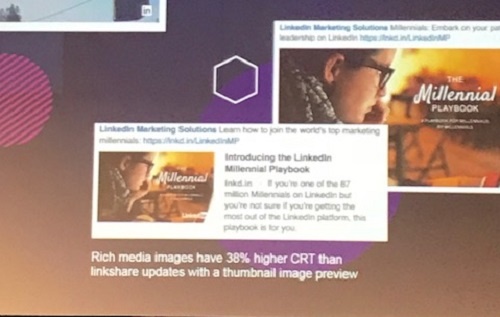
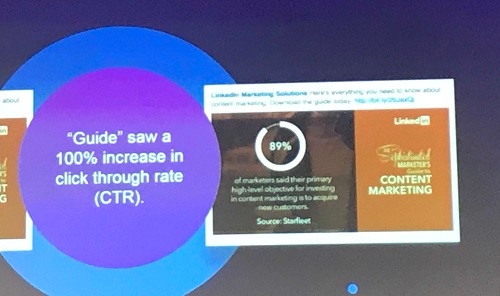
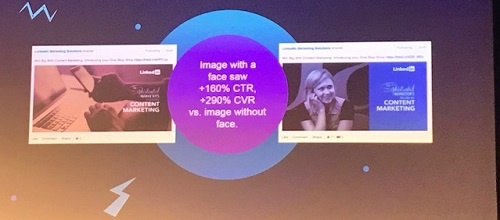
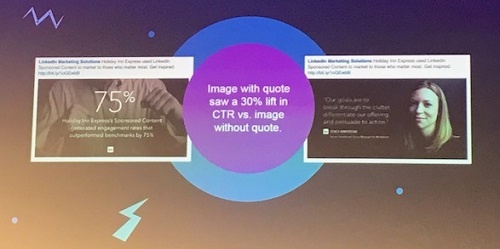
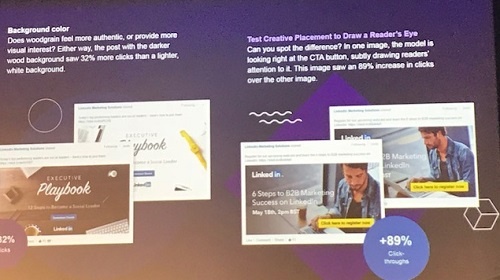
Treat Content Like An Asset On Your Balance Sheet. Invest In It.
The final keynote came from my good friend, and ex-SAP colleague, Michael Brenner (@BrennerMichael). I love social media. The fact it can bring friends together from across the world to meet in person – just brilliant! Anyway, Michael talked about brand storytelling but more importantly, authentic storytelling. A topic close to my heart – employee-generated content. The point is, employees are already sharing content about the brand online. Encourage them to become your authentic voice.
Here’s a summary:
- Content is an investment over time. It’s an asset. Accelerate revenue through storytelling
- Stories must convey emotion and true engagement starts with emotion
- Your big idea is the problem you solve.
- Make customers the hero of your story
- Check out healthessentials.com as an example of how a company has created a content-driven way of connecting with audiences focused on value not volume
- Elevate experts on LinkedIn
- Help your employees discover their passion, tell their story and drive an authentic/human side of the brand
- Want to know what stories to tell? Check out BuzzSumo, Google Trends, Answer the Public
- Look for what people are asking and searching for. Give them the answer.
- The Pixar storytelling framework:
- Once upon a time…
- Every day…
- One day…
- Because of that..
- Because of that…
- Until finally…
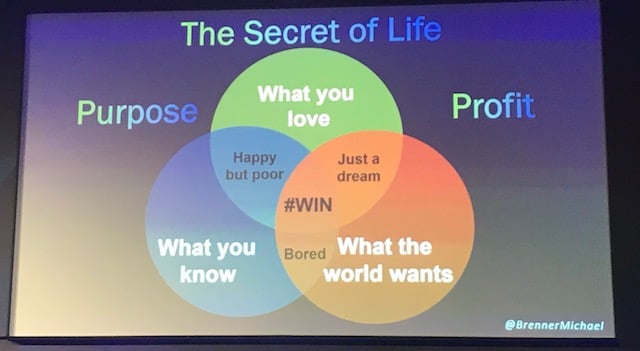
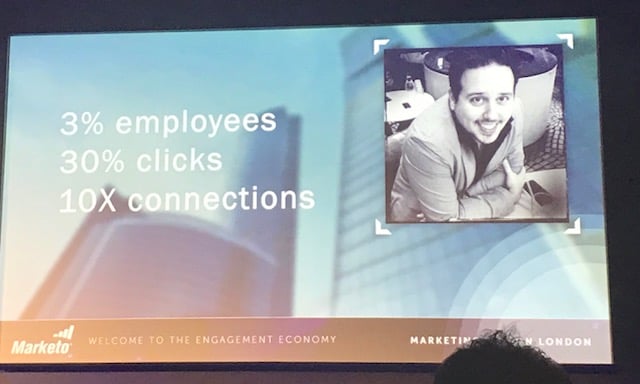
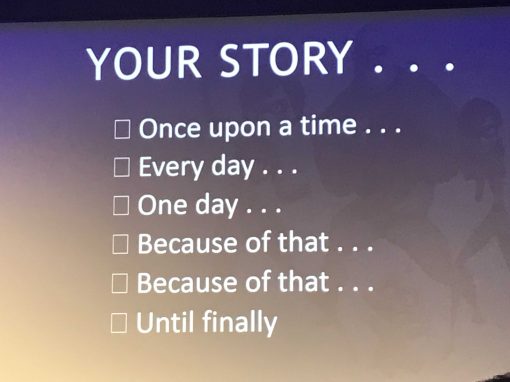
Summary
Apart from the event leaving me inspired, educated and generally so happy to be working in marketing at the moment, there was just one niggle that I had. Several times the presenters kept referring to leads – creating quality leads, more leads, better-qualified leads. I get that the whole marketing and sales alignment thing is far from sorted, but all the time the conversation is about leads we’ll be hitting a brick wall in my humble opinion.
You see, my philosophy is pretty simple. You craft a marketing strategy that doesn’t need to drive leads. You craft a marketing strategy that attracts. It attracts business, customers, prospects, partners and talent.
You don’t have to decide when the right moment is to pick up the phone and close that deal. You don’t have to monitor when that lead score has just hit the top mark and triggers an action to be made from the company.
Why?
Because no matter where people are in the buying cycle, they don’t like to be sold to. Focus on making it easier, convenient and a great experience. Let them come in their own time. What’s more, they’ll come back. Even better, they’ll tell their network.
Anyway, I’m open to bve convinced otherwise. What do you think? Too much too soon? Inbound business just a pipedream?
